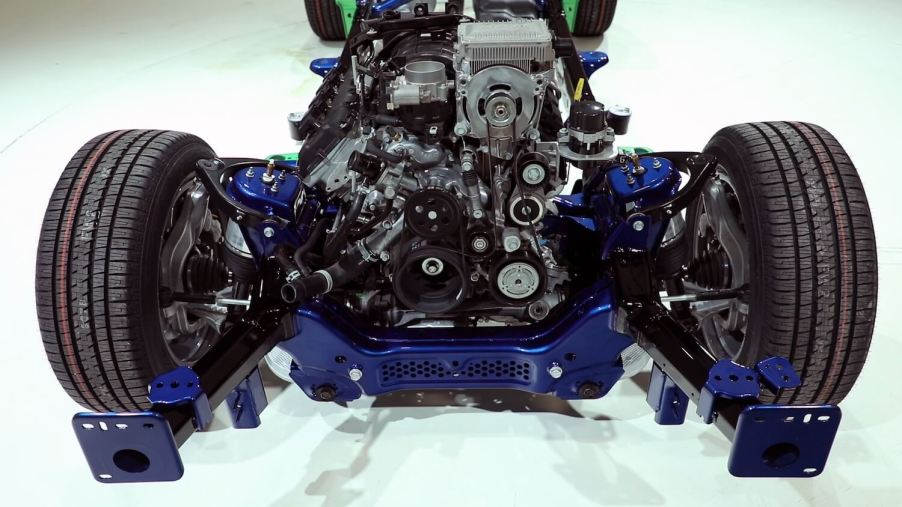
Smart Truck Buyers Know Engine Choice Has Little to Do With Their Half-Ton Pickup’s Towing Capacity
Truck folks, we need to talk. We pickup people love bragging about what engine our truck has, listing displacement numbers, and rattling off lb-ft of torque. I’m no different. But Detroit engineers know that the engine is rarely the weak link in a modern pickup truck. Want an example? Look no further than your truck’s advertised maximum towing capacity: automakers can achieve these capacities with any powerplant they choose.
Which half-ton engine is the best for towing?
Almost every entry-level half-ton truck has an engine that is gentle on mpg but only makes about 300 lb-ft of torque–so not great for towing. Once you upgrade to any 400+ lb-ft engine (turbo diesel, turbo V6, naturally-aspirated V8), your towing capacity is limited by your cooling system and rear-end ratio.

Yup, you read that right. There honestly isn’t a bad half-ton truck engine upgrade for towing. How do I know? Pickup truck manufacturers publish the configuration they use to test every model year’s maximum towing capacity. Look at the range of powertrains in the 2023 trucks in the table below:
| Make and Model | Max Towing Capacity | Configuration |
| Ford F-150 | 14,000 pounds | 3.5-liter EcoBoost V6 |
| Chevrolet Silverado 1500 | 13,300 pounds | 3.0-liter turbodiesel Duramax I6, double cab, 2WD, max trailering package, and 20-inch wheels |
| GMC Sierra 1500 | 13,000 pounds | 3.0-liter turbodiesel Duramax I6, double cab, 4WD, max trailering package, and 20-inch wheels |
| Ram 1500 | 12,750 pounds | 5.7-liter HEMI V8 with eTorque |
| Toyota Tundra | 12,000 pounds | 2WD SR5 (turbocharged V6) with the tow package |
| Nissan Titan | 9,320 pounds | King Cab 4×2 |
How do automakers test maximum towing capacity?
Most truck and SUV manufacturers test their own vehicles’ towing capacity by hauling a heavy trailer up the “Davis Dam” grade of Arizona State Route 68. The Society of Automotive Engineers (SAE) recommends this “Highway Gradeability” test because of the area’s heat and elevation change.

Testers hook their trucks up to a trailer in the Nevada desert at an elevation of 500 feet. Then they drive 11.4 miles across the Colorado River and to an elevation of 3,500 feet in the mountains of Arizona. They only conduct tests on 100+ degree days.
There are a series of parameters: the truck must be able to get up to 30 mph in 12 seconds and slow down from 60 mph in 30 seconds. But the real test is whether the vehicle can survive climbing the steep highway grade at low speeds while sucking hot desert air.
When automakers want to claim a higher maximum towing capacity, they take a test truck to Nevada, hook up a heavy trailer, and complete the Davis Dam run. If the truck passes (survives), they add more weight and go again.
The test is designed to simulate the most difficult towing conditions a truck buyer would realistically face. The idea is that pickup manufacturers can advertise the weight of their heaviest successful Davis Dam run with a clear conscience.
Do automakers have a towing capacity ‘gentlemen’s agreement?’
If you examine the half-ton truck maximum towing capacity chart above, you’ll notice something interesting about the engines: they are all different. The General Motors pickups (the Silverado and Sierra) ran turbodiesels during their Davis Dam test. The latest Ram 1500 tested its 5.7-liter Hemi V8. Ford brought an F-150 with the 3.5-liter EcoBoost V6.

Towing capacity is a major marketing point. You’d think they would all bring their most effective engine. The truth is that these tow rating test trucks are all carefully configured with maximum cooling capacity and a high rear-end ratio. In fact, the engine they run matters little. So that opens up an interesting marketing opportunity.
In advertising materials, GMC brags that its Sierra 1500 has the highest 4WD diesel tow rating in its class. Meanwhile, Chevrolet can claim the Silverado 1500 has the highest 2WD diesel tow rating of any half-ton. Ram is quick to say the 1500 has the highest tow rating of any V8 in the segment, while Ford proudly announces the highest half-ton rating overall. But if any new truck were to surpass the F-150, Ford could still claim the highest of any turbocharged V6.
Ford might be able to take an F-150 with its 5.0-liter “Coyote” V8 to Davis Dam and beat the Ram’s “V8” record. But there seems to be an unannounced “gentlemen’s agreement” between the Detroit Three not to do exactly that. It’s either that, or running a second Davis Dam test out of spite would be too much work.
Next, find out why serious truck buyers don’t even care about half-ton pickups’ advertised towing capacity, or learn more about the Davis Dam towing test in the video below:






